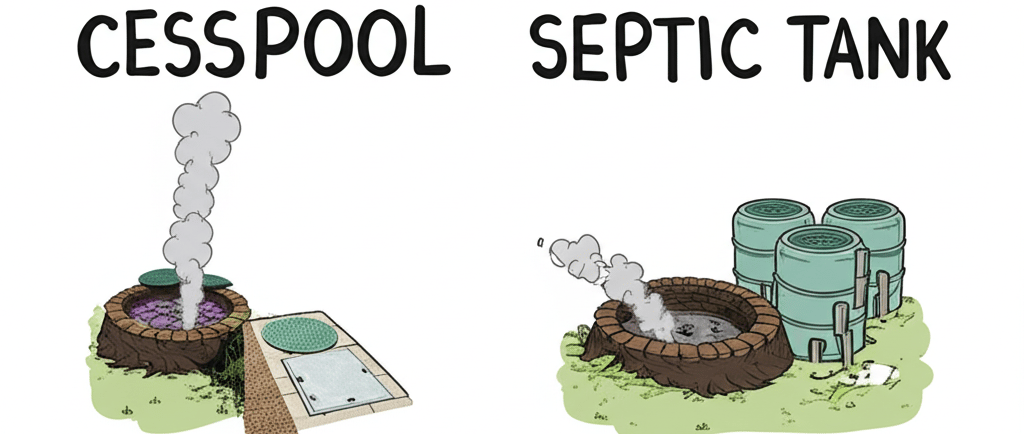Septic vs Cesspool
What's the difference and does it matter?
Thomas Brady
2/12/20256 min read


Septic vs. Cesspool: What's Lurking Beneath Your Long Island Lawn? 🏡❓
Out of Sight, Doesn't Mean Out of Mind!
For many Long Island homeowners not connected to public sewer lines, the destination of household wastewater is a crucial, often unseen, aspect of property ownership. Hundreds of thousands of homes across Suffolk and Nassau counties rely on individual, on-site systems to handle everything that goes down the drain.1 Understanding whether a property utilizes a cesspool or a septic system is critically important, particularly given Long Island's unique environmental sensitivities and evolving regulations. The differences between these two types of systems are significant, impacting not only household function but also environmental health and property management. 🤔
The Cesspool: A Blast from the Past 🕰️
A cesspool represents an older approach to wastewater disposal. Its fundamental characteristics include:
Structure: Typically, a cesspool is a pit lined with materials like concrete blocks, bricks, or precast concrete rings.2 A defining feature is that it often has perforated sides and/or an open bottom, designed to allow liquids to seep out.5
Function: All household wastewater – encompassing waste from toilets 🚽, sinks, showers 🚿, and washing machines 🧺 – flows directly into this single containment structure.6
The Critical Distinction - Lack of Treatment: The most crucial aspect of a cesspool is its inability to treat the sanitary waste it receives. It functions primarily as a holding vessel that allows untreated liquids (effluent) containing human excreta and other contaminants to leach directly into the surrounding soil.6 While designed to capture waste, cesspools offer no mechanism for breaking down pollutants or filtering the effluent before it enters the ground.2
Historical Context: Cesspools were widely implemented in the past, particularly in rural and suburban areas lacking centralized sewer infrastructure, primarily due to their simpler design and lower initial construction cost compared to more complex systems.2 Consequently, many older homes on Long Island are still served by these systems.1 They are now widely considered "antiquated".3
The operational principle of a cesspool—direct discharge of untreated waste into the ground—is its defining characteristic and the source of significant environmental concern, especially in sensitive areas like Long Island.
The Septic System: A Smarter Approach ✨
A conventional septic system offers a more sophisticated, multi-stage approach to managing household wastewater. It generally consists of two primary components:
The Septic Tank: Wastewater first flows from the house into a buried, watertight container, typically made of concrete, fiberglass, or polyethylene.8 Inside this tank, a crucial separation process occurs naturally. Heavier solids settle to the bottom, forming sludge, while lighter materials like oils and grease float to the top, forming scum.8 This separation retains the bulk of the solids within the tank, preventing them from moving downstream.
The Drainfield (or Leach Field): The partially clarified liquid wastewater, known as effluent, exits the septic tank and flows into a drainfield.8 This component consists of a network of perforated pipes laid in gravel-filled trenches or beds within unsaturated soil.8
The Critical Distinction - Treatment Process: As the effluent slowly disperses from the perforated pipes into the soil of the drainfield, the soil itself acts as a natural filter. This soil absorption field is designed not just for disposal but for treatment. Soil microbes and natural processes break down and remove many harmful components, including disease-causing pathogens (like coliform bacteria and viruses) and some nutrients, before the treated water eventually percolates down towards the groundwater.7 This treatment step is the fundamental advantage of a septic system over a cesspool. 🌱💧
While conventional septic systems provide treatment, alternative designs may incorporate additional components like pumps, sand filters, or constructed wetlands to enhance treatment, especially on sites with challenging soil or space conditions.8
Why the Difference Matters (Especially Here on Long Island!) ⚠️
The distinction between wastewater treatment (septic systems) and non-treatment (cesspools) is profoundly important for Long Island. The island's unique geography and population density create specific vulnerabilities:
Protecting Critical Water Resources: Long Island relies heavily on underground aquifers as its primary source of drinking water.5 Its surrounding bays, harbors, and coastal ecosystems are environmentally sensitive and economically vital for fishing and recreation 🏖️🎣. The fundamental design of cesspools, lacking any treatment mechanism 2, directly conflicts with the need to protect these sensitive resources. The direct leaching of untreated effluent introduces high levels of contaminants into the very aquifers and surface waters the island depends upon.5
The Nitrogen Problem: A major issue is nitrogen pollution. Untreated household wastewater is rich in nitrogen compounds, primarily from human waste.10 When cesspools release this untreated effluent directly into the ground, nitrogen converts to nitrate, a form that travels easily through Long Island's sandy soils into the groundwater.10 This nitrate eventually discharges into coastal waters, acting like a fertilizer that fuels harmful algal blooms (including brown tides), depletes oxygen needed by marine life leading to fish kills, and contributes to beach closures.1 Studies identify cesspools and outdated septic systems as the single largest source of nitrogen pollution impacting Long Island's water bodies.1 😬
Pathogens and Health Risks: Beyond nitrogen, untreated effluent from cesspools contains pathogens like bacteria and viruses.6 These contaminants pose a direct threat to human health if they migrate into nearby drinking water wells or contaminate surface waters used for swimming or shellfish harvesting.6 Septic systems significantly reduce these risks through the soil filtration process.8
Advanced Systems for Enhanced Protection: While conventional septic systems offer treatment, they are typically not designed to remove substantial amounts of nitrogen.10 Recognizing this, there is a significant push on Long Island towards installing advanced septic systems, often referred to as Innovative and Alternative Onsite Wastewater Treatment Systems (I/A OWTS). These systems incorporate technologies specifically designed to significantly reduce nitrogen levels in the effluent before it reaches the drainfield, offering a higher level of environmental protection.3 The development and promotion of these advanced systems represent a key strategy in addressing Long Island's nitrogen pollution crisis.
What's the Deal for LI Homeowners? 🤔
For homeowners on Long Island, the presence of a cesspool or an older septic system carries increasing regulatory, financial, and logistical implications:
Aging Infrastructure and Stricter Regulations: Many cesspools still in use are decades old and constructed from materials like cement blocks, making them prone to structural failure or collapse.3 Simultaneously, environmental regulations are becoming more stringent. Notably, Suffolk County prohibits the installation of new cesspools and often mandates the replacement of a failing cesspool with a modern septic system, sometimes even triggering replacement requirements upon property transfer in designated high-priority environmental areas.4 Nassau County also restricts new cesspools and promotes upgrades.4 This regulatory environment reflects a growing understanding of the environmental damage caused by outdated systems.
Upgrade Costs vs. Financial Incentives (The Good News!): Replacing a cesspool or failing septic system with a modern, nitrogen-reducing I/A OWTS can be a significant expense, potentially costing between $15,000 and $30,000.4 However, recognizing the critical need for these upgrades to protect water quality, substantial financial assistance is available. Both Suffolk County (through its "Reclaim Our Water" Septic Improvement Program - SIP) and Nassau County (through its Septic Environmental Program to Improve Cleanliness - S.E.P.T.I.C.) administer grant programs, often combined with New York State funds.1 These programs can provide homeowners with grants covering a significant portion of the replacement cost (e.g., up to $10,000 from the state fund plus potential county funds, potentially totaling $20,000 or more depending on eligibility and location) specifically for installing nitrogen-reducing systems.1 Information can typically be found via county websites like ReclaimOurWater.info (Suffolk) or the Nassau County S.E.P.T.I.C. program page.1 Low-interest loans may also be available to cover remaining costs.1 The tightening regulations and availability of these grants reflect a broader, necessary shift across Long Island. This transition aims to replace outdated, polluting cesspools with modern systems capable of mitigating environmental damage, particularly nitrogen pollution, representing a significant regional infrastructure upgrade driven by environmental protection mandates.1 ➡️💰
Property Value, Inspections, and Peace of Mind: Upgrading from a cesspool to an advanced septic system can potentially enhance property value.4 It also provides homeowners with assurance against potential system failures and avoids the uncertainty of future mandatory upgrades triggered by regulatory changes or property sales.3 For prospective homebuyers considering a property with an existing cesspool or older septic system, obtaining a specialized inspection beyond the standard home inspection is highly recommended to assess the system's condition and compliance with local codes.4 Owning a property with a cesspool involves distinct financial and logistical considerations. The potential for system failure 3, triggering mandatory and costly upgrades 4, represents a significant financial liability. Navigating grant applications 3 and securing financing for remaining costs 1 adds complexity.
Ongoing Maintenance Responsibility: It is important to note that the advanced I/A OWTS systems require regular professional maintenance to ensure their continued effectiveness, particularly for nitrogen removal. Homeowners are typically required to maintain a service contract with a licensed provider, involving inspections and maintenance usually once or twice per year, with annual costs often around $300.12 This represents a shift from the often passive ownership of older systems to a more active management role required for the newer, more complex technologies.
Conclusion: Know Your System ✅
The fundamental difference between the two main types of on-site wastewater systems found on Long Island is clear: Septic systems provide treatment for wastewater, while cesspools do not. This distinction has profound consequences for the island's groundwater quality, coastal ecosystems, and public health.
Understanding which system serves a property is the essential first step for any Long Island homeowner or potential buyer. Given the environmental risks associated with cesspools, their aging nature, and the increasing regulatory pressure for replacement, investigating the status of an existing cesspool is prudent. Exploring the significant grant programs offered by Nassau and Suffolk Counties can make upgrading to a modern, nitrogen-reducing septic system a more financially viable option. Protecting Long Island's vital water resources is a shared responsibility, and informed decisions about wastewater management at the individual property level play a crucial role in this collective effort. 👍🌊 Being informed about a property's wastewater system is essential for responsible homeownership on Long Island.
Vintage American Realty, LLC
Vintage American Realty, LLC is licensed in the State of New York
office: 631.319.4564
broker: 631.816.0719
info@vintageamericanrealty.com
1551 Montauk Hwy, Ste E
Oakdale, NY 11769
Long Island, NY


